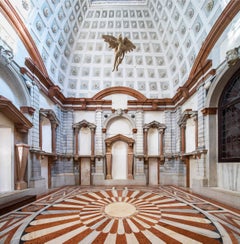Giovanni Salviati
Reinhard Görner, Ganymed, Palazzo Grimani, Venice
By Reinhard Görner
Located in Los Angeles, CA
Camerino di Apollo, with frescoes by Francesco Salviati and Giovanni da Udine; the Sala del Doge Antonio
Category
21st Century and Contemporary Conceptual Landscape Photography
Materials
C Print, Lambda
Recent Sales
Portrait of Giovanni Rucellai (1403-1481) Huge Antique Oil Painting
Located in Cirencester, Gloucestershire
Portrait of Giovanni Rucellai (1403-1481)
Italian School, 19th century
After Francesco Salviati
Category
19th Century Old Masters Figurative Paintings
Materials
Canvas, Oil
Frosted Blue Murano Glass Vase by Ercole Barovier for Barovier & Toso circa 1970
By Ercole Barovier
Located in Forest Row, East Sussex
is the oldest glass company in Italy, dating back as far as 1295. in the late 1800s Giovanni Barovier
Category
Vintage 1970s Italian Vases
Materials
Murano Glass
H 13 in W 5.52 in D 3.75 in
Frosted Blue Murano Glass Vase by Ercole Barovier for Barovier & Toso circa 1970
By Ercole Barovier
Located in Forest Row, East Sussex
is the oldest glass company in Italy, dating back as far as 1295. In the late 1800s Giovanni Barovier
Category
Vintage 1970s Italian Vases
Materials
Murano Glass
H 9.45 in W 5.91 in D 2.76 in
Barovier Scalloped Pink Bowl with Gold Inclusions
Located in New York, NY
1877 by Antonio Salviati, Giovanni Barovier, and his cousins. It went under the name Artisti Barovier
Category
Vintage 1950s Italian Glass
Materials
Glass
Get Updated with New Arrivals
Save "Giovanni Salviati", and we’ll notify you when there are new listings in this category.
Giovanni Salviati For Sale on 1stDibs
With a vast inventory of beautiful furniture at 1stDibs, we’ve got just the giovanni salviati you’re looking for. Frequently made of glass, murano glass and metal, every giovanni salviati was constructed with great care. You’ve searched high and low for the perfect giovanni salviati — we have versions that date back to the 19th Century alongside those produced as recently as the 20th Century are available. A giovanni salviati is a generally popular piece of furniture, but those created in Art Deco, Arts and Crafts and Victorian styles are sought with frequency. Many designers have produced at least one well-made giovanni salviati over the years, but those crafted by Artisti Barovier, Guggenheim Museum and Pauly et Cie are often thought to be among the most beautiful.
How Much is a Giovanni Salviati?
The average selling price for a giovanni salviati at 1stDibs is $7,551, while they’re typically $1,850 on the low end and $307,389 for the highest priced.
More Ways To Browse
Barovier And Toso Murano Glass
Res Murano
Murano Glass 70s
Murano Copper Glass
Barovier Toso Murano Glass Gold
Used Glass Furnace
Murano With Applied Glass
Murano Glass Cups
Antique Carved Armoire
Wave Murano Glass
Large Murano Glass Centerpieces
Bellini Italian Vase
Fratelli Toso Murano Art Glass
Murano Glass Paperweights
Hand Carved Wardrobe
Brazilian Vintage Ceramics
Italian Armoire
19th Century Murano Art Glass


